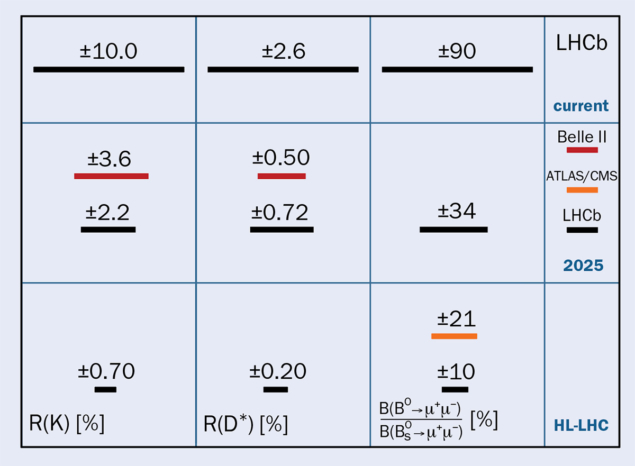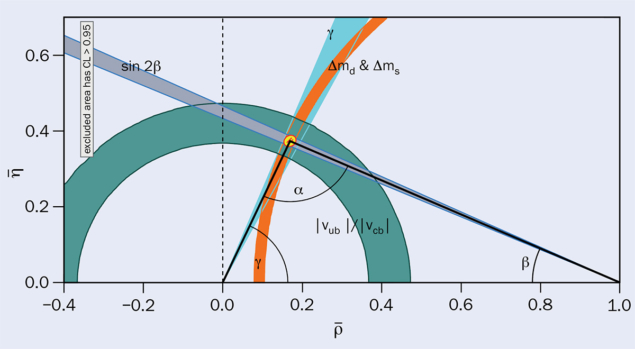In addition to significant improvements on the precision of CP-violating and rare B-decay observables, Run 3 will bring the flavour anomalies into sharp focus. Basem Khanji gives the full story.

The famous “November revolution” in particle physics in winter 1974 was sparked by the discovery of the charm quark by two independent groups at Brookhaven and SLAC. It signalled the existence of a second generation of fermions, and was therefore a milestone in establishing the Standard Model (SM). Less widely known is that, four years earlier, the Glashow–Iliopoulos–Maiani (GIM) mechanism had postulated the existence of the charm quark to explain the smallness of the K0 → μ+μ– branching fraction. In addition, in the summer of 1974, the puzzling smallness of the mass difference between neutral kaons, which was apparent from kaon mixing, led Gaillard and Lee to conclude, correctly, that the charm mass should be below 1.5 GeV.
Many historical discoveries in particle physics have followed this pattern: a measurement in flavour physics generated a theoretical breakthrough, which in turn led to a direct discovery. The 1977 discovery of the beauty quark at Fermilab was a confirmation of the Cabibbo–Kobayashi–Maskawa (CKM) mechanism postulating the existence of three generations of fermions, which was put forward following the experimental discovery of CP violation in the kaon system in 1964. In 1987, hints of a surprisingly large value for the top-quark mass were inferred from the first measurement of B0-meson oscillations at the Argus experiment, and confirmed in 1995 by the discovery of the top quark at the Tevatron.
This critical role of the flavour sector in particle physics is by no means accidental. Since new particles can contribute virtually via loops or box diagrams, precision measurements in flavour physics in tandem with precise theoretical predictions can provide sensitive probes to indirectly search for new particles or interactions at high energy scales. Could the historical role of flavour measurements in elucidating new-particle discoveries be about to repeat itself at the LHC?
The flavour promise

Following the Higgs-boson discovery in 2012, the next target at the LHC was clear: to search for an indisputable sign of an eagerly awaited mass peak as a signature for a new particle beyond the SM. So far, however, it seems nature might have something else in store. To unearth the new physics that is strongly motivated to exist – to explain phenomena such as the arbitrary mass hierarchy of elementary particles, the matter–antimatter imbalance in the universe and the origin of the CKM matrix – we should also consider the historically successful route though flavour physics.
Flavour processes are governed by loop diagrams such as “box” and “penguin” diagrams (see “Virtual production” figure), in which new heavy particles can contribute virtually and alter our expectations. The key word here is “virtually”. This peculiarity of quantum physics allows us to probe new physics at very high energy scales, even if the collision energy is not sufficient to produce new particles directly. Any significant discrepancy between flavour measurements and theoretical calculations would provide us with a valuable lead towards hidden new physics.
Cooking up a storm
On the experimental side, the main ingredient required is a large sample of beauty and charm hadrons. This makes the LHC, and the LHCb experiment in particular, the ideal place to carefully test the flavour structure of the SM. Not only does the LHC have a record energy reach, it also combines a large production cross-section for beauty and charm hadrons with a very high instantaneous luminosity. There is one catch, however. Due to the nature of quantum-chromodynamics, a large number of hadrons are produced in proton–proton collisions, saturating the different sub-detectors (see “Asymmetric complexity” image). Flavour measurements require a full understanding of this complex event environment, which is a much more challenging task compared to that at e+e– colliders where only a low number of particles is produced in each collision.

Since the inauguration of the LHC, its four main experiments have discovered more than 50 new hadronic states. Most follow the expected pattern of the original quark model, whereas some are new forms of matter such as the doubly-heavy “tetraquark” Tcc+ or bound states of five quarks, the so-called pentaquarks, discovered by LHCb. Since the early planning of the LHC, the mission of the flavour community was to better understand the behaviour of beauty and charm quarks. Indeed, in 2019 LHCb was the first single experiment to observe the mixing and CP violation of neutral charm mesons. Similarly for beauty decays, the first observation of time-integrated and time-dependent CP-violating Bs decays was made at the LHC. The unique properties and structure of the CKM matrix connect seemingly unrelated flavour observables, most of which are accessible through B decays. Accurate flavour measurements thus simultaneously allow the CKM matrix to be probed, and precise theory predictions to be scrutinised.
Unturned stones
Today, the LHC dominates the flavour sector, with an important parallel programme ongoing at Belle II in Japan. Between them, the LHC experiments have made the most precise measurement of matter–antimatter oscillations in the neutral B system, measured CP violation in B mesons, discovered rare B decays and determined CKM elements such as Vtb. So far no measurement has yielded a significant disagreement with SM expectations. However, some interesting hints have emerged, and a couple of stones have not yet been turned.
Since the inauguration of the LHC, its four main experiments have discovered more than 50 new hadronic states
A promising opportunity to probe physics beyond the SM arises through b → sℓℓ and b → cℓν transitions in various hadron decays. The latter proceed through tree-level transitions in processes that are abundant and well-understood: the decay is mediated by a charged W boson that changes the b quark into a c quark, emitting a lepton and an antineutrino. In b → sℓℓ processes, the quark flavour changes through the emission of a Z boson or a photon. This flavour-changing neutral-current process occurs through a higher order penguin diagram, and underlies a breed of suppressed and thus rare hadron decays. The SM makes a slew of precise predictions for flavour observables for both types of transitions. However, new-physics models include yet-unobserved particles that can potentially contribute virtually.
A number of flavour observables are particularly well predicted within the SM. Well-known examples are the lepton-flavour-universality observables R(K), which compare the decay rates of b → sℓℓ decays containing muons to those containing electrons, and R(D), which compares b → cℓν decay rates with muons and tau leptons in the final state. The theoretical precision for these ratios reach an impressive relative uncertainty of about 1%. But other measurable flavour quantities in these two transitions, such as absolute decay rates or angular observables, are more challenging due to the limited knowledge of gluon exchange between hadrons in the initial and final states.

Intriguingly, all b → sℓℓ flavour observables measured by the b-factories LHCb, Belle and BaBar, and also ATLAS and CMS, collectively, point in a similar direction away from SM predictions. This has led to speculation that new heavy particles are changing the rate of B-meson decays to different lepton flavours, violating the SM principle of lepton-flavour universality. The contributions of such particles are quantified “effectively” – similar to the way Fermi described weak decays in terms of a single coupling constant instead of the underlying W-boson propagator. New particles that contribute to B decays can affect many different types of couplings, depending on their spin or handedness. Remarkably, the current flavour anomalies seem to affect only one or two effective couplings (left-handed vector and axial couplings, known as C9 and C10), and these can be visualised in a single two-dimensional plane of new-physics contributions (see “New couplings” figure). Data from b → cℓν transitions also exhibit hints for anomalous lepton-flavour non-universality.
The picture that seems to be emerging could be explained by models that involve leptoquarks or Z′ bosons (CERN Courier May/June 2019 p33). The flavour anomalies measured at the LHC disagree with the SM at the level of 2–3.5σ, which is insufficient to confirm the presence of new physics. To address these and other unanswered questions in the flavour sector, the available data sample need to be expanded.
Luminous future
The LHCb experiment will operate at Run 3 at an increased instantaneous luminosity, and with an improved data acquisition system. Together, this will enable a 10-fold increase of the sample size. The price to pay for this increased luminosity is the daunting number of overlapping collisions in a single proton-bunch crossing, which makes the task of sifting through billions of collisions to identify interesting topologies a challenge. Novel technologies such as graphics processing units have been incorporated in LHCb’s trigger system to speed up the processing of busy hadronic events, while new detectors have been built to reconstruct charged particle tracks, find the vertex position and to identify the particle species using state-of-the-art readout electronics (CERN Courier May/June 2022 p38). The LHCb upgrades completed during LS2 will also serve the experiment for Run 4 beginning in 2029, which is the start of the ambitious High-Luminosity LHC (HL-LHC) project.

During the next few years of Run 3, the LHCb experiment is expected to collect an integrated luminosity of 20–25 fb–1 (compared to 6 fb–1 in Run 2). This will enable significant improvements on the precision of CP-violation observables and rare B-decay measurements. The expectation is to improve the precision on possible CP violation in Bs0 – Bs0 mixing to 10–3, on CP violation in the interference between mixing and decay in Bs → J/ψϕ decays to about 14 mrad, and on the CKM angle γ to 1.5°. Further probes of possible lepton-flavour non-universality are another key target. The ratios of electroweak penguin processes involving b → sℓℓ transitions, R(K) and R(K*), are expected to be determined with a precision between three to two per cent, and ratios of semileptonic b → cℓν processes R(D*) to a precision below one per cent (see “Anomaly squeeze” figure).
The flavour sector delivered a great harvest in the first 10 years of LHC operations
The flavour programme in the era of the HL-LHC is even more rich and diverse. Many directions are being pursued, including precision measurements targeting CP violation and mixing in charm and beauty, and measurements of CP-conserving quantities such as the magnitudes of the CKM elements Vub, Vcb and Vtb. The end goal is to study every possible constraint to scrutinise the overall CKM picture within the SM (see “Triangulating” figure). Regarding the anomalous b → sℓℓ and b → cℓν transitions, the long-term projections for the LHC experiments are clear: if new phenomena are found, then their detailed characteristics will be established. The large data sample at the end of the HL-LHC will also allow tests of lepton-flavour violation in b → sℓℓ transitions involving tau leptons. The power of such indirect searches is their ability to elucidate the energy scale at which new particles might be present, and could point the way for the next generation of colliders.
The flavour sector delivered a great harvest in the first 10 years of LHC operations: new particles and new forms of matter were discovered, new behaviour of matter was established, stringent constraints on the CKM matrix were set and intriguing flavour anomalies have appeared. That success is only the beginning. The higher luminosity phase of the LHC beginning with Run 3 will undoubtedly generate further knowledge of particle physics, and might unveil deeper layers of nature beyond the SM.





